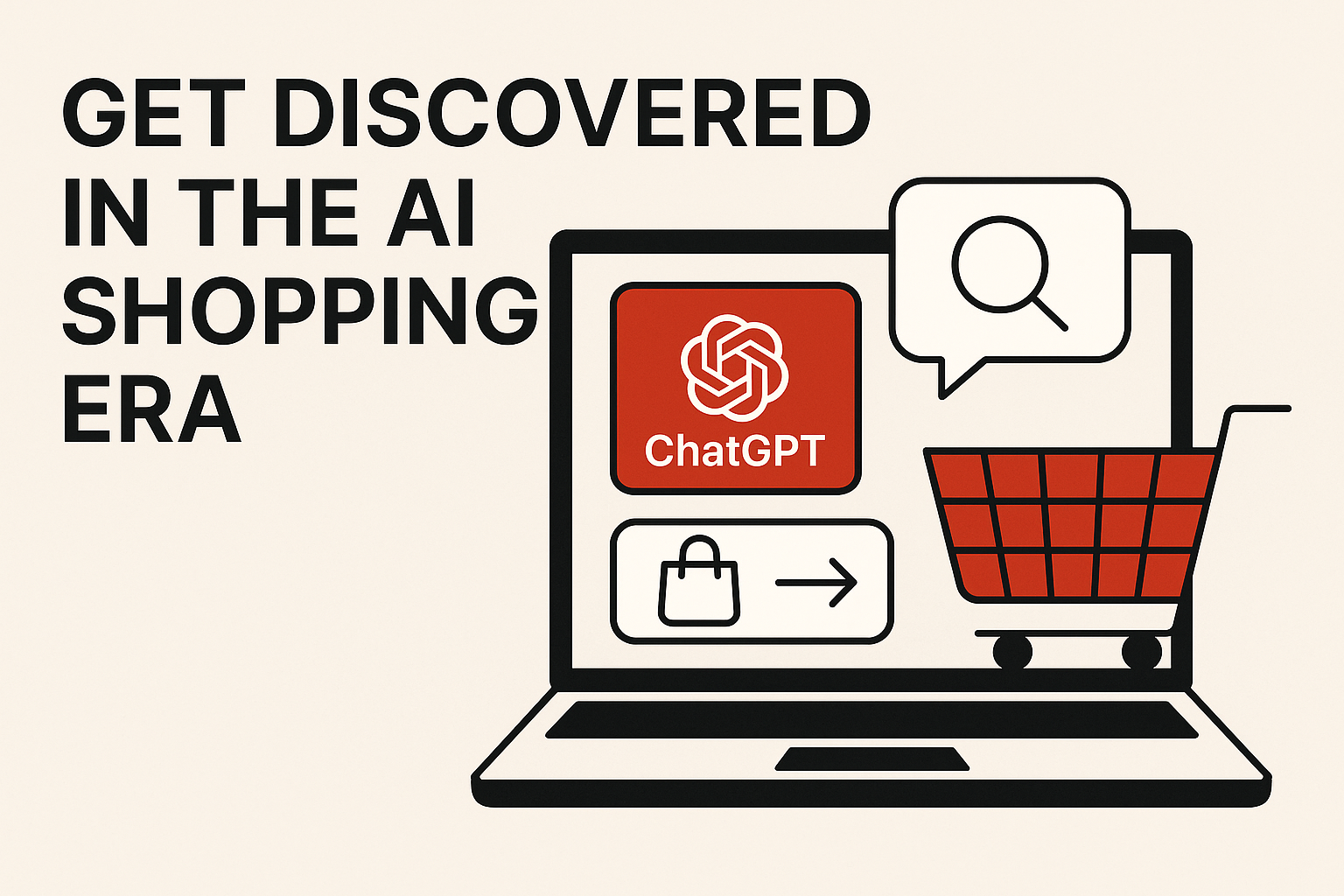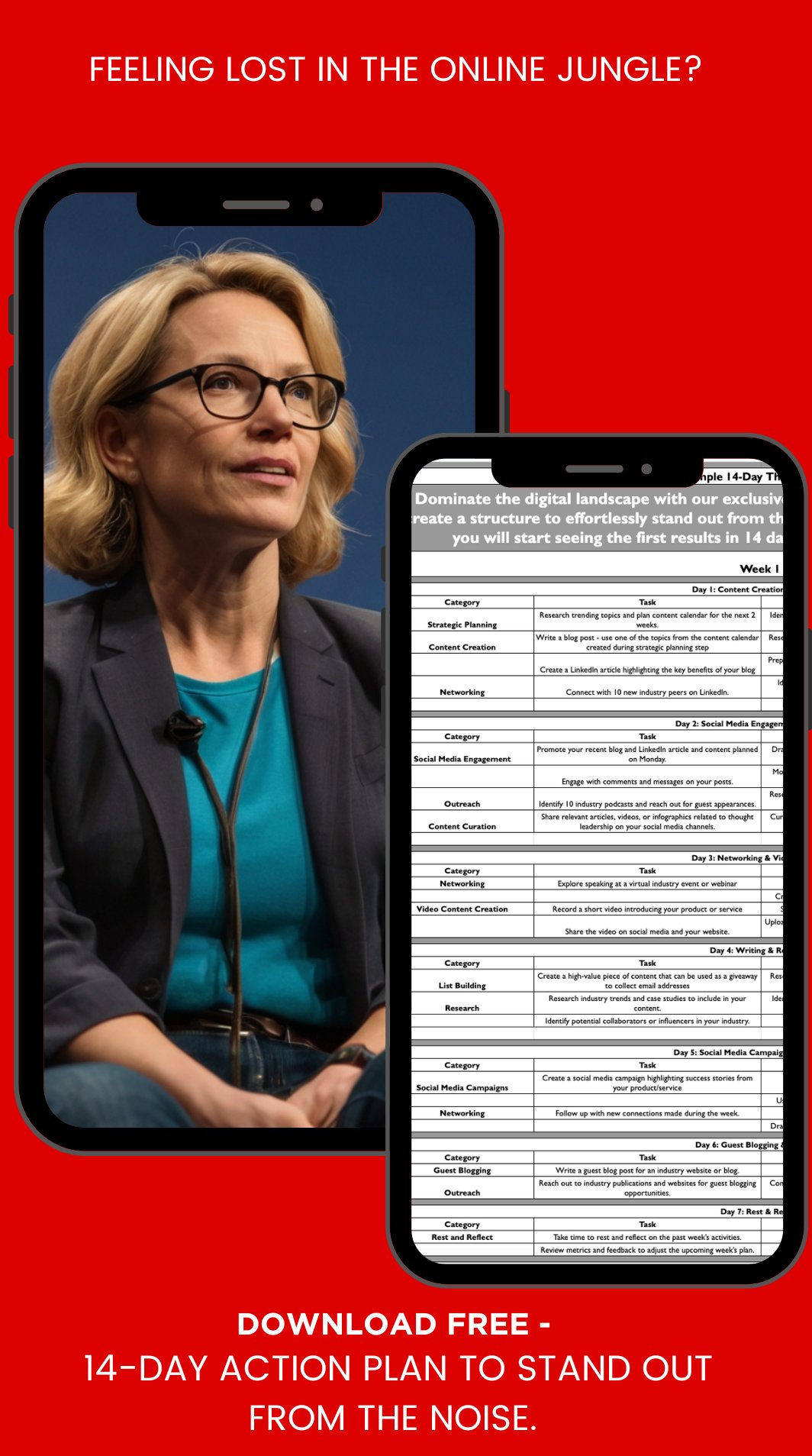Raise your hand if you ever had a goal to make $1,000,000 a year. Does it still feel like a farfetched goal?
Many online marketing gurus teach tell us: publish content, share it on social media, create interesting offers, grow our lists, and, magically, see our business grow to 7 figures a year.
Well, I am a huge believer in the power of content, making the right offers, and creating funnels. If put into the system and applied consistently, content + funnels + traffic will result in business success.
But what these marketing gurus are not telling us is that it takes more than a marketing system.
Yes, $1,000,000 a year is a huge number.
Success is NOT easy to achieve, and it most certainly does NOT happen overnight. Unless Elon Musk mentions your product and you see your stock price grow exponentially.
But I digress.
Table of Contents
ToggleThe $1M Mindset: More Than Just a Number
Before we crunch the numbers, let’s address the elephant in the room: why $1M?
Is it just an arbitrary milestone, or does it represent something more?
For many tech CEOs, hitting the $1M mark is akin to breaking the sound barrier. It’s not just about the money—it’s about proving your concept, validating your market fit, and setting the stage for exponential growth. It’s the point where your startup transforms from a scrappy underdog to a serious contender.
But let’s be honest: the path to $1M is paved with sleepless nights, pivot-induced headaches, and the constant fear of running out of runway. Sound familiar?
Breaking Down the Million-Dollar Equation
Now, let’s get to the meat of our strategy. How do we turn this lofty goal into a tangible, achievable target?
The basic formula is deceptively simple:
$1,000,000 = (Number of Customers) x (Average Revenue per Customer)
But as any seasoned CEO knows, the devil is in the details. Let’s break this down further:
- The Customer Acquisition Game
- How many customers do you need?
- What’s your current customer acquisition cost (CAC)?
- How can you optimize your funnel to bring this number down?
- The Revenue Maximization Strategy
- What’s your average revenue per customer?
- How can you increase this through upselling, cross-selling, or pricing optimization?
- The Scalability Factor
- Can your current infrastructure support rapid growth?
- Where are the potential bottlenecks in your operations?
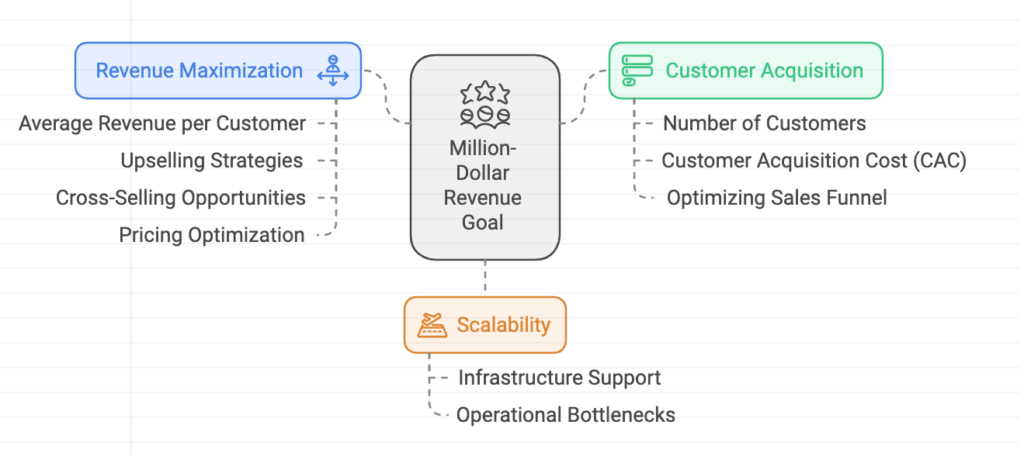
Let’s explore each of these elements in depth.
1. Mastering Customer Acquisition: Quality Over Quantity
Here’s a truth bomb: not all customers are created equal. In the race to $1M, your goal isn’t just to acquire any customer—it’s to acquire the right customers.
Ideal Customer Profile (ICP) Development
Start by creating a laser-focused Ideal Customer Profile. Ask yourself:
- Who benefits most from your product?
- Which customers have the lowest churn rate?
- Who are your most profitable customers?
Once you’ve identified your ICP, tailor your entire acquisition strategy around them. This might mean saying “no” to potential customers who don’t fit the profile. Remember, in the world of SaaS, a bad fit customer can cost you more than no customer at all.
Optimizing Your CAC
Your Customer Acquisition Cost is the linchpin of your growth strategy.
Here’s how to keep it in check:
- Leverage content marketing: Create high-value, SEO-optimized content that addresses your ICP’s pain points. This attracts qualified leads at a fraction of the cost of paid advertising.
- Implement a referral program: Turn your satisfied customers into your best salespeople. A well-structured referral program can significantly lower your CAC.
- Automate your funnel: Use marketing automation tools to nurture leads efficiently. This allows you to scale your outreach without linearly increasing your marketing spend.
- A/B test everything: From your landing pages to your email subject lines, continuous testing and optimization can dramatically improve your conversion rates.

Remember, reducing CAC isn’t just about spending less—it’s about spending smarter.
2. Revenue Maximization: The Art of the Upsell
Now that we’re acquiring the right customers efficiently, let’s focus on maximizing the value of each relationship.
Tiered Pricing Strategy
Implement a tiered pricing structure that aligns with your customers’ growth journey. For example:
- Basic Tier: Entry-level offering for small teams or startups
- Pro Tier: Enhanced features for growing businesses
- Enterprise Tier: Full-suite solution with dedicated support for large organizations
This structure not only caters to different customer segments but also provides a clear upgrade path as your clients grow.
The Power of Add-Ons
Identify complementary services or features that provide additional value to your core offering. These could be:
- Advanced analytics modules
- Integration with popular third-party tools
- Priority support packages
By offering these as add-ons, you create multiple opportunities to increase your average revenue per customer without alienating price-sensitive users.
Implement a Customer Success Program
A robust customer success program isn’t just about reducing churn—it’s about identifying upsell opportunities. Train your customer success team to:
- Regularly review usage patterns to spot potential upgrade candidates
- Provide proactive training on advanced features
- Conduct quarterly business reviews to align your product’s value with the customer’s evolving needs
Remember, it’s often easier (and more cost-effective) to generate additional revenue from existing customers than to acquire new ones.
3. Building for Scale: Prepare for Liftoff
As you implement these strategies, you’ll likely see your revenue graph start to hockey stick. But can your infrastructure handle this growth?
Audit Your Tech Stack
Conduct a thorough audit of your current technology stack. Ask yourself:
- Can our servers handle a 10x increase in traffic?
- Is our database optimized for rapid growth?
- Are our internal tools built for efficiency at scale?
Identify potential bottlenecks before they become critical issues. This might mean investing in more robust cloud infrastructure or refactoring parts of your codebase for better performance.
Streamline Your Operations
As you scale, operational inefficiencies that were once minor annoyances can become major roadblocks. Focus on:
- Automating repetitive tasks: Use tools like Zapier or custom scripts to automate routine processes.
- Documenting everything: Create comprehensive playbooks for all key operations. This ensures consistency as you scale your team.
- Implementing scalable customer support: Consider AI-powered chatbots or a knowledge base to handle common queries, freeing up your support team for more complex issues.
Cultivate a Data-Driven Culture
As your company grows, gut feelings won’t cut it anymore. Implement robust analytics across all aspects of your business:
- Set up real-time dashboards for key metrics
- Train your team to make data-driven decisions
- Regularly review and adjust your KPIs to align with your growth goals
Remember, what gets measured gets managed.
Reverse-Engineering Your Revenue Goal and Pricing Model
Now that we’ve covered the high-level strategies, let’s dive deeper into the math behind reaching that coveted $1M mark. It’s time to play with some numbers and see how different pricing models can get you to your goal.
The Basic Math

At its core, making $1,000,000 online is simply a numbers game. Let’s start with the most basic formula:
Sell widgets for $1 apiece to 1,000,000 customers and you will have $1,000,000 in revenue
Sounds simple, right? But here’s the catch: you have to find 1,000,000 people to buy these widgets. Your costs may be too high, and it may take too long to reach that many customers.
Let’s adjust our model:
If your widgets are $100 apiece, you’ll need to sell 100,000 widgets to make $1M.
Better than 1,000,000, but still quite a lot!
What if you sold widgets at $1,000 or $10,000 apiece?
Now we’re talking! At $1,000 per widget, you’d need 1,000 customers. At $10,000, you’d only need 100.
The Subscription Model
Now, let’s make things even more interesting. What if you were selling a monthly subscription service?
- If you sell your service for $16.7/mo, you would need roughly 5,000 subscribers: $16.7 x 5,000 x 12 = $1,002,000
- If you increase your price to $84/mo, you will just need 1,000 people: $84 x 1,000 x 12 = $1,008,000
- Want to have even fewer subscribers? Offer 250 people a $334/mo subscription: $334 x 250 x 12 = $1,002,000
Starting Smaller
Not ready for a $1,000,000 goal yet? Let’s scale it back:
- 25 people buying a monthly $334 plan from you: $334 x 25 x 12 = $100,200
That’s a 6-figure income from figuring out a high-value, relatively low-cost product and selling it to just 25 people!
To visualize these different models, take a look at this comparison:
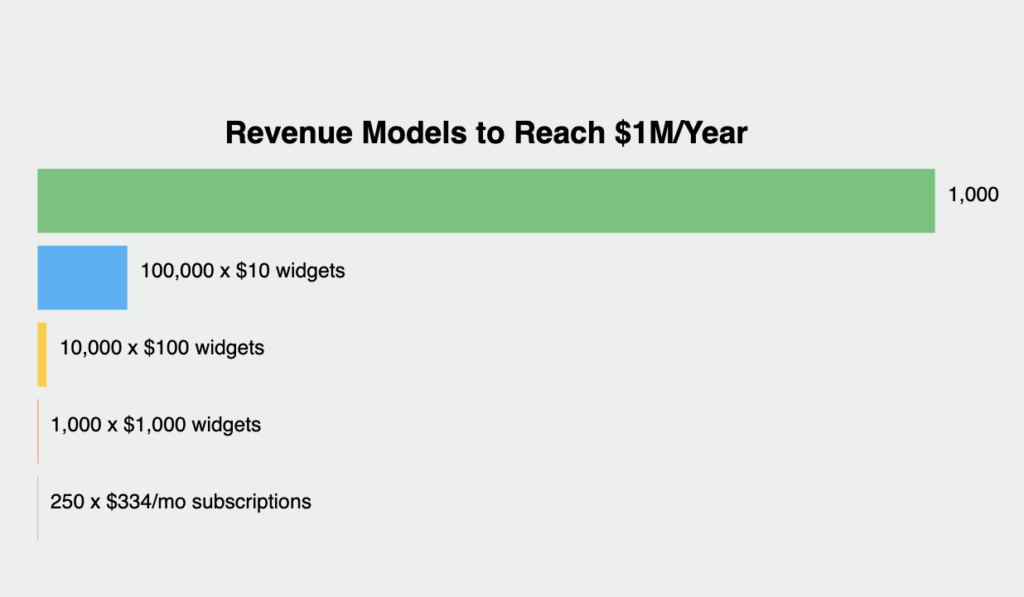
This visual representation helps you quickly grasp how different pricing strategies can lead to the same revenue goal.
The key is finding the right balance between price and volume that works for your specific product or service.
Reality-Checking Your Numbers
Once you’ve played with these numbers and found a model that seems achievable, it’s time for a reality check. Let’s say you’ve decided on a $99/mo product. This means you’ll need to acquire and maintain about 950 customers every month to hit your $1M goal.
Now, ask yourself:
- What would it take to acquire 950 customers?
- What’s the cost?
- How will you market to them?
- How much time would it take?
- Can your business support and provide quality service to 950 customers simultaneously?
- What processes and systems do you need to put in place to support them?
- How large would your team need to be?
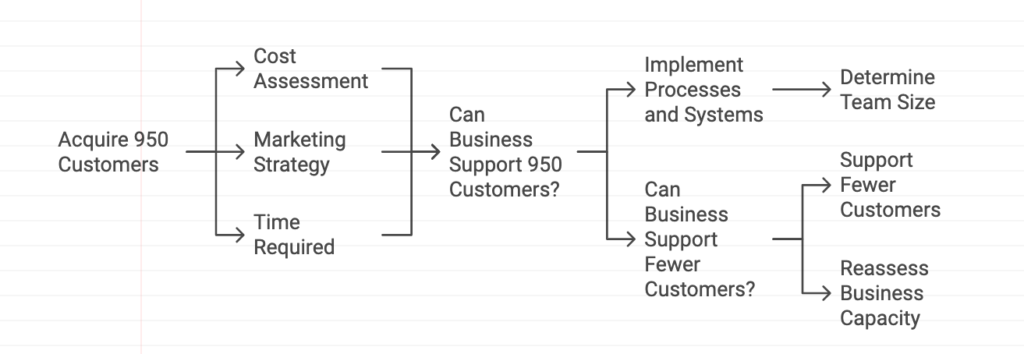
Digital Products vs. Services
If you’re selling membership access to digital products or running an eCommerce business, your support costs might be lower. Your main concern becomes the cost of acquiring and retaining those 950 customers.
As a rule of thumb, subscribers often stay with a service for 4-6 months. This means that over a year, you might need to acquire at least 1,900 customers:
(950 customers x 6 months) x 2 = 1,900 customers per year
However, if you’re a freelancer, an agency, or a Done-For-You services provider, supporting that many customers every month may not be feasible. This is on top of acquiring and retaining them!
An average freelancer can typically provide quality support to no more than 10 customers at the same time. Let’s do the math:
- At $99/mo: $99 x 10 x 12 = $11,880 per year
- At $999/mo: $999 x 10 x 12 = $119,880 per year

See the difference?
You can increase the price and reduce the number of customers to stay at the same revenue goal, OR increase the price and keep the customer count the same to make more.
Diversifying Your Revenue Model
One of the biggest challenges for many businesses is managing ebbs and flows in revenue. Different business models face different seasonal challenges:
- eCommerce: The holiday season might be your biggest revenue maker, followed by a slow January.
- Coaching/Consulting: Summer months and holidays might be slow, with a rush of clients in the new year.
To keep a stable cash flow, consider these three key strategies:
- Create an Automated Lead Generation System: This will continue bringing potential customers into your business even when you’re busy serving existing clients.
- Develop Multiple Revenue Streams: Don’t rely on a single product or service. Diversify to balance out seasonal fluctuations.
- Implement a Recurring Revenue Model: Subscription-based services or retainer agreements can provide more predictable income.
Putting It All Together: Your Million-Dollar Roadmap
Now that we’ve broken down the key elements, let’s put it all together into an actionable roadmap:
- Month 1-3: Lay the Groundwork
- Define your Ideal Customer Profile
- Audit your current tech stack and operations
- Implement basic analytics across all key business functions
- Month 4-6: Optimize Acquisition
- Launch a content marketing strategy targeting your ICP
- Implement and test a referral program
- A/B test all key elements of your acquisition funnel
- Month 7-9: Maximize Revenue
- Roll out a tiered pricing structure
- Develop and launch your first set of add-on features
- Train your customer success team on identifying upsell opportunities
- Month 10-12: Scale and Refine
- Address any scalability issues identified in your tech stack
- Implement advanced automation for key operational processes
- Develop a data-driven culture with regular metric reviews and adjustments

The Million-Dollar Mindset: Beyond the Numbers
As we wrap up, it’s crucial to remember that hitting $1M in revenue is more than just a financial milestone—it’s a testament to the value you’re creating in the market.
But here’s the kicker: the strategies we’ve discussed aren’t just about reaching $1M. They’re about building a sustainable, scalable business that can grow well beyond this initial target.
As you implement these tactics, keep asking yourself:
- How can we 10x this process?
- What would break if we grew 100x overnight?
- Are we solving a big enough problem?
These questions will push you to think beyond immediate goals and build a truly scalable, impactful business.
The Road Ahead: Your Next Million Awaits
Reaching $1M in annual revenue is an incredible achievement, but it’s just the beginning of your journey. As you hit this milestone, you’ll face new challenges:
- How do you maintain your company culture as you scale?
- When is the right time to raise your next round of funding?
- How do you balance innovation with the demands of a growing customer base?
These are good problems to have, and they’re the hallmarks of a business on the path to lasting success.
Remember, the journey to $1M isn’t just about the destination—it’s about building the systems, culture, and mindset that will propel your company to even greater heights.
So, are you ready to embark on your million-dollar journey? The math is simple, the path is clear, and your next big milestone awaits. It’s time to turn that startup dream into a seven-figure reality.
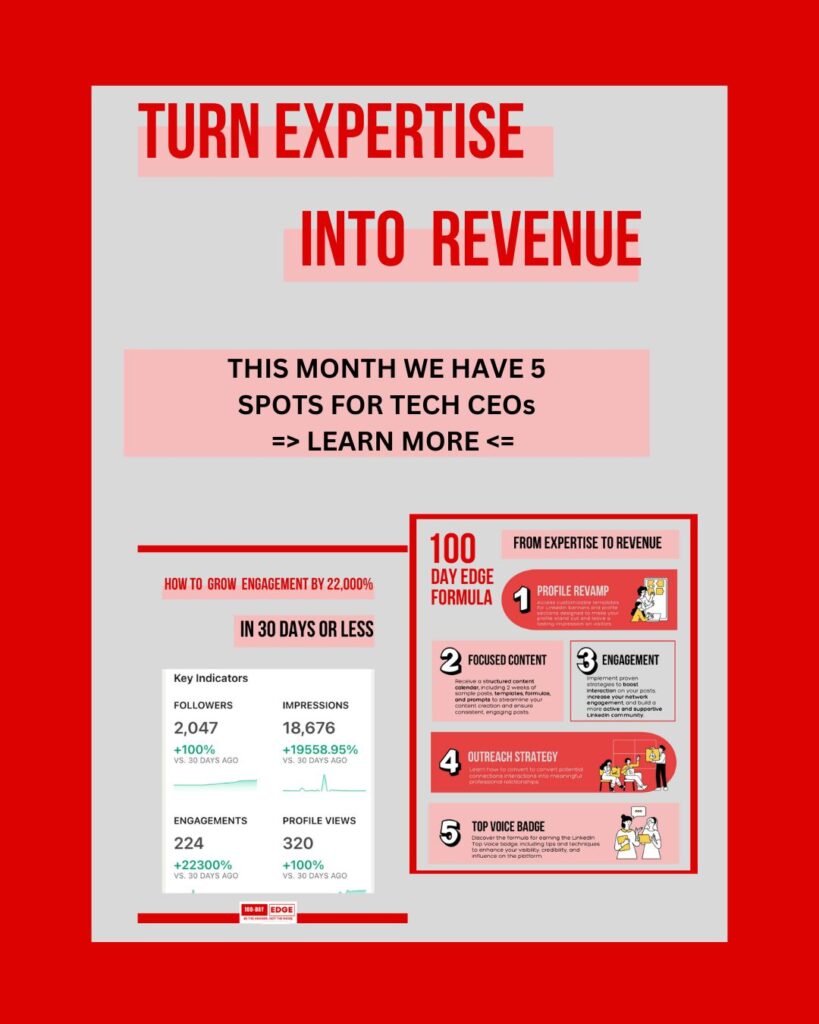
This month, my team is helping 5 technology leaders transform their expertise into tangible business results.
In 100 days, you’ll:
- Stage 1: Define your EDGE and optimize your online presence.
- Stage 2: Engage your tribe and land your first high-value client.
- Stage 3: Set your EDGE on fire with strategic content and recurring revenue.





